EVGA GeForce GTX 680 Superclocked Signature 2 Graphics Card Review

Today we are going to talk about one more unique graphics accelerator based on GeForce GTX 680 GPU. How does it differ from the previously reviewed Hi-End graphics accelerators on Nvidia “Kepler” processor?
We keep on checking out original versions of the GeForce GTX 680 graphics card. Recently, we’ve taken a look at the MSI N680GTX Lightning and today we want to test a product from the renowned EVGA. The company has never been into original coolers, preferring to equip its graphics cards with slightly optimized reference cooling systems. But everything changes sooner or later, and this time around we’ve got an exception.
So, we are going to talk about a graphics card which is called EVGA GeForce GTX 80 SC Signature 2:
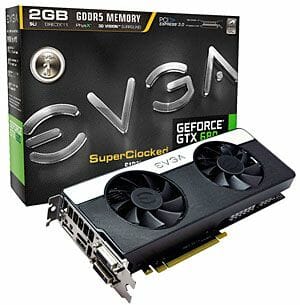
Interestingly, the official EVGA website says that this product can only be ordered singly. Only one device for one buyer. The company seems to regard this graphics card as something special if they take such a careful approach to its distribution. So, let’s see what secrets are hidden under the name of EVGA GeForce GTX 680 SC Signature 2.
Technical Specifications
The detailed technical specifications of the new EVHA GeForce GTX 680 SC Signature 2 card are summed up in the table below side by side with those of the reference Nvidia GeForce GTX 680 (the differences are marked with bold font):
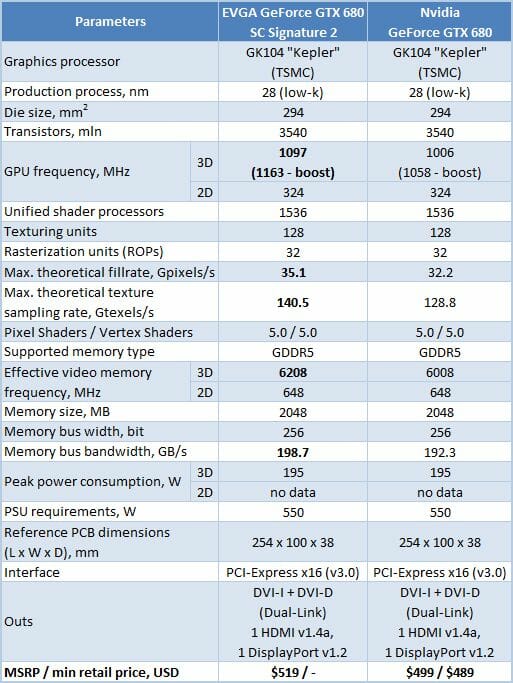
Packaging and Accessories
The cardboard box with the card is rather small and designed in EVGA’s traditional colors.The product’s model name, size and type of onboard memory and supported Nvidia technologies are all indicated on the front of the box.
Product specs, hardware and software requirements, and a list of the card’s video outputs can be found on the back of the box. There is a small window there for checking out the ID number on the card’s PCB. The product is additionally sealed into a plastic blister wrap, but we guess the conventional protection in the way of soft foam material would be preferable.
The EVGA GeForce GTX 680 SC Signature 2 is shipped together with two power cables (two PATA power connectors -> one 6-pin connector), a DVI->D-Sub adapter, user manuals, stickers, a CD with drivers and utilities, and a huge calendar.
The card is manufactured in China and comes at a recommended price of $519.99. This is a mere $20 higher than the recommended price of the ordinary GeForce GTX 680 2GB. Running a little ahead, we can say that the difference in price is more than justifiable. The product is shipped with a 3-year warranty.
Design and Features
The EVGA GeForce GTX 680 SC Signature 2 looks very serious. A black-and-silver plastic casing with two fans and an EVGA logo covers the entire face side of the PCB.
The reverse side of the PCB is open, as is usually the case. The SLI connectors are protected with a rubber cap. The graphics card model and the manufacturer are indicated on the cooler’s plastic casing.There is a vent grid in the card’s mounting bracket to exhaust the hot air from the cooler out of the system case.
There are quite a lot of vent holes here, even above the DVI connectors, although the cooler design doesn’t really call for that. The video interfaces include DVI-I and DVI-D (dual-channel), HDMI and DisplayPort. Their connectors are all covered with rubber caps.
Two MIO connectors for building 2-, 3- and 4-way SLI configurations can be found in their conventional location, just like the 8-pin and 6-pin power connectors.
The peak power consumption of the GeForce GTX 680 is specified at 195 watts. A 550-watt PSU is recommended for a computer with one such graphics card. The EVGA GeForce GTX 680 SC Signature 2 is no different from the reference sample in this respect.
Its PCB follows the reference GeForce GTX 680 design as well, but has the full number of power components.The reference GeForce GTX 680 has four GPU power phases whereas the EVGA version has five.Thus, the power system formula is 5+2 (GPU+memory). The GPU voltage regulator is managed by a Richtek RT8802A controller.
The 28nm GK104 Kepler chip was manufactured in Taiwan on the 12th week of 2012 (mid-March). It is revision A2.The base GPU clock rate is 1097 MHz in 3D mode (boosted up to 1163 MHz), which is 9.1% higher than the reference card’s. That’s substantial factory overclocking although some GTX 680s, for example from ASUS and MSI, come with even higher clock rates. The GPU frequency is dropped to 324 MHz in 2D mode to save power. The voltage is also dropped then, from 1.175 to 0.987 volts.
The FCBGA-packaged GDDR5 chips were manufactured by Hynix Semiconductor.Labeled H5GQ2H24MFR R0C, they are rated for 6000 MHz but the memory frequency of the EVGA GeForce GTX 680 SC Signature 2 is set at 6208 MHz (higher by 3.5%). The memory bus is 256 bits.
Cooling System: Efficiency and Noise
The original cooling system installed on the EVGA GeForce GTX 680 SC Signature 2 has no proper name, unlike many other original coolers, yet this doesn’t make it any worse. First of all, we must note that this EVGA cooler fits within the dimensions of the reference GeForce GTX 680 and blocks only one adjacent PCIe slot on the mainboard. Then, it is simple in design, which must be the reason why the graphics card doesn’t cost much more than ordinary GeForce GTX 680s.
So, the cooler consists of a nickel-plated dual-section heatsink and a plastic casing with fans.There are four heat pipes, 8 millimeters in diameter, piercing through the whole length of the heatsink. The main heatsink is rather slim and light and has a hollow for one of the fans.
The auxiliary heatsink is made of aluminum fins soldered to the pipes. The pipes are soldered to the cooler’s base as well, even though it’s hard to see any trace of soldering there.
The whole arrangement is cooled by two fans installed in the plastic casing.The fans are 80 millimeters in diameter (the impellers are 75 millimeters actually), but their increased height (15 millimeters instead of the conventional height of 10 to12 millimeters) helps them produce higher pressure and ensure higher performance at low speeds.
The 9-blade impellers were manufactured by Power Logic. Their part number is PLA08015S12HH.As is indicated on the label, the fans run on sleeve bearings. Their speed is PWM-regulated from 1100 to 4170 RPM (according to our monitoring tools). The peak power consumption of each fan is no higher than 4.2 watts.
We checked out the card’s temperature during five consecutive runs of Aliens vs. Predator (2010) game with the highest image quality settings in 2560×1440 resolution with 16x anisotropic filtering and MSAA 4x antialiasing).
We used MSI Afterburner 2.2.3 and GPU-Z 0.6.4 as monitoring tools. This test was performed inside a closed system case at 22°C room temperature. All thermal tests were carried out before we took the card apart, i.e. with its default thermal interface still intact.
The GPU temperature is 74°C with the fans regulated automatically. The number doesn’t look impressive, but check out the peak speed of the fans. It is only 1440 RPM. We’ll see shortly how quiet this is, but subjectively the EVGA GeForce GTX 680 SC Signature 2 didn’t seem to disturb the quiet of our testbed. At the maximum speed of the fans the card is of course loud, but the GPU is as cool as 53°C under peak load. So, the original cooler from EVGA is highly efficient, now let’s check out how noisy it is.
The noise level of each cooler was measured after 1:00 AM in a closed room about 20 m2 big using CENTER-321 electronic noise meter. The noise level for each cooler was tested outside the system case when the only noise sources in the lab were the cooler and its fan. The noise meter was installed on a tripod and was always at a 150 mm distance from the cooler fan rotor. The tested cooling systems were placed at the edge of the desk on a sheet of polyurethane foam. The lowest noise reading our noise meter device can register is 29.8 dBA and the subjectively comfortable noise level in these testing conditions was around 36 dBA (do not mix it up with low noise level). The fans rotation speeds were adjusted in the entire supported range using our in-house controller by changing the voltage with 0.5 V increment.
We’ll test the EVGA GeForce GTX 680 SC Signature 2 against reference Nvidia GeForce GTX 680 and AMD Radeon HD 7970 cards as well as against an ASUS GeForce GTX 680 DirectCU II TOP which features one of the quietest coolers we’ve ever seen. The vertical dotted lines mark the speed of the fans in the automatic regulation mode. Here are the results.
Although the noise graph of the EVGA GeForce GTX 680 SC Signature 2 goes close to the noise graph of the reference AMD Radeon HD 7970 which is rather loud, the EVGA is much quieter. Why? Take note of the peak speed of the fans in the automatic regulation mode. The AMD Radeon HD 7970 can get as loud as 59 dBA with its fans regulated automatically whereas the EVGA card produces only 41 dBA of noise then (measured from a distance of 15 centimeters, by the way). The difference is huge. The EVGA cooler is also quieter than the reference GeForce GTX 680 but cannot beat the DirectCU II cooler from ASUS. The latter remains the quietest solution we’ve ever seen on mass-produced graphics cards, perhaps being only inferior to the Arctic Xtreme series.
Overclocking Potential
We tried to overclock our EVGA GeForce GTX 680 SC Signature 2 with the Power Limit set to the maximum of 125%.We only managed to increase the base GPU clock rate by 65 MHz and the memory clock rate by 760 MHz.The resulting frequencies were 1163/1228/6968 MHz.
That’s not much of overclocking for an original graphics card. But the frequency gain is rather high compared to the reference GeForce GTX 680: +15.6% for the GPU and +16% for the graphics memory.
The overclocked card had a 2°C higher temperature of the GPU and the speed of its fans increased by 160 RPM.Increasing the GPU voltage by 100 millivolts didn’t help us reach higher clock rates, so we had to stop at those we had achieved at the default voltage.
Testbed Configuration and Testing Methodology
All participating graphics cards were tested in a system with the following configuration:
- Mainboard: Intel Siler DX79SI (Intel X79 Express, LGA 2011, BIOS 0537 from 7/23/2012);
- CPU: Intel Core i7-3960X Extreme Edition, 3.3 GHz, 1.2 V, 6 x 256 KB L2, 15 MB L3 (Sandy Bridge-E, C1, 32 nm);
- CPU cooler: Phanteks PH-TC14PE (2 x 135 mm fans at 900 RPM);
- Thermal interface: ARCTIC MX-4;
- System memory: DDR3 4 x 4GB Mushkin Redline (Spec: 2133 MHz / 9-11-10-28 / 1.65 V);
- Graphics cards:
- AMD Radeon HD 7970 GHz Edition 3 GB 384 bit GDDR5, 1050/6000 MHz and 1250/6680 MHz at 1.3 V;
- EVGA GeForce GTX 680 SC Signature 2 2 GB 256 bit GDDR5, 1097/6208 MHz and 1163/6968 MHz;
- Asus GeForce GTX 680 DirectCU II TOP 2 GB 256 bit GDDR5, 1137/6008 MHz;
- Nvidia GeForce GTX 680 2 GB 256 bit GDDR5, 1006/6008 MHz;
- System drive: Crucial m4 256 GB SSD (SATA-III,CT256M4SSD2, BIOS v0009);
- Drive for programs and games: Western Digital VelociRaptor (300GB, SATA-II, 10000 RPM, 16MB cache, NCQ) inside Scythe Quiet Drive 3.5” HDD silencer and cooler;
- Backup drive: Samsung Ecogreen F4 HD204UI (SATA-II, 2 TB, 5400 RPM, 32 MB, NCQ);
- System case: Antec Twelve Hundred (front panel: three Noiseblocker NB-Multiframe S-Series MF12-S2 fans at 1020 RPM; back panel: two Noiseblocker NB-BlackSilentPRO PL-1 fans at 1020 RPM; top panel: standard 200 mm fan at 400 RPM);
- Control and monitoring panel: Zalman ZM-MFC3;
- Power supply: Xigmatek “No Rules Power” NRP-HC1501 1500 W (with a default 140 mm fan);
- Monitor: 27” Samsung S27A850D (DVI-I, 2560×1440, 60 Hz).
In order to lower the dependence of the graphics cards performance on the overall platform speed, I overclocked our 32 nm six-core CPU with the multiplier set at 37x, BCLK frequency set at 125 MHz and “Load-Line Calibration” enabled to 4.625 GHz. The processor Vcore was increased to 1.47 V in the mainboard BIOS.
Hyper-Threading technology was enabled. 16 GB of system DDR3 memory worked at 2 GHz frequency with 9-10-10-28 timings and 1.65V voltage.
The test session started on August 23, 2012. All tests were performed in Microsoft Windows 7 Ultimate x64 SP1 with all critical updates as of that date and the following drivers:
- Intel Chipset Drivers 9.3.0.1021 WHQL from 07/27/2012 for the mainboard chipset;
- DirectX End-User Runtimes libraries from November 30, 2010;
- AMD Catalyst 12.8 (8.982.0.0) driver from 08/15/2012 + Catalyst Application Profiles 12.7 (CAP3) for AMD based graphics cards;
- Nvidia GeForce 305.37 beta driver from 07.27.2012 for Nvidia based graphics cards.
We ran our tests in the following two resolutions: 1920×1080 and 2560×1440. The tests were performed in two image quality modes: “Quality+AF16x” – default texturing quality in the drivers with enabled 16x anisotropic filtering and “Quality+ AF16x+MSAA 4(8)x” with enabled 16x anisotropic filtering and full screen 4x or 8x antialiasing if the average framerate was high enough for comfortable gaming experience. We enabled anisotropic filtering and full-screen anti-aliasing from the game settings. If the corresponding options were missing, we changed these settings in the Control Panels of Catalyst and GeForce drivers. We also disabled Vsync there. There were no other changes in the driver settings.
Today’s testing suite includes one popular semi-synthetic benchmark and 8 most resource-demanding games of various genres with all updates installed as of the beginning of the test session date:
- 3DMark 2011 (DirectX 11) – version 1.0.3.0, Performance and Extreme profiles;
- Metro 2033: The Last Refuge (DirectX 10/11) – version 1.2, maximum graphics quality settings, official benchmark, “High” image quality settings; tesselation, DOF and MSAA4x disabled; AAA aliasing enabled, two consecutive runs of the “Frontline” scene;
- Aliens vs. Predator (2010) (DirectX 11) – Texture Quality “Very High”, Shadow Quality “High”, SSAO On, two test runs in each resolution;
- Total War: Shogun 2 (DirectX 11) – version 2.0, built in benchmark (Sekigahara battle) at maximum graphics quality settings;
- Crysis 2 (DirectX 11) – version 1.9, we used Adrenaline Crysis 2 Benchmark Tool v.1.0.1.13. BETA with “Ultra High” graphics quality profile and activated HD textures, two runs of a demo recorded on “Times Square” level;
- Battlefield 3 (DirectX 11) – version 1.4, all image quality settings set to “Ultra”, two successive runs of a scripted scene from the beginning of the “Going Hunting” mission 110 seconds long;
- DiRT Showdown (DirectX 11) – version 1.0, built-in benchmark at maximum graphics quality settings (“Ultra” preset) on the “Nevada” track.
- Sniper Elite V2 Benchmark (DirectX 11) – version 1.05, we used Adrenaline Sniper Elite V2 Benchmark Tool v1.0.0.2 BETA with maximum graphics quality settings (“Ultra” profile), Advanced Shadows: HIGH, Ambient Occlusion: ON, Stereo 3D: OFF, two sequential test runs.
- Sleeping Dogs (DirectX 11) – version 1.0, maximum image quality settings, Hi-Res Textures pack installed, FPS Limiter and V-Sync disabled, two consecutive runs of the built-in benchmark with quality antialiasing at Normal and Extreme levels.
If the game allowed recording the minimal fps readings, they were also added to the charts. We ran each game test or benchmark twice and took the best result for the diagrams, but only if the difference between them didn’t exceed 1%. If it did exceed 1%, we ran the tests at least one more time to achieve repeatability of results.
Performance
Metro 2033: The Last Refuge
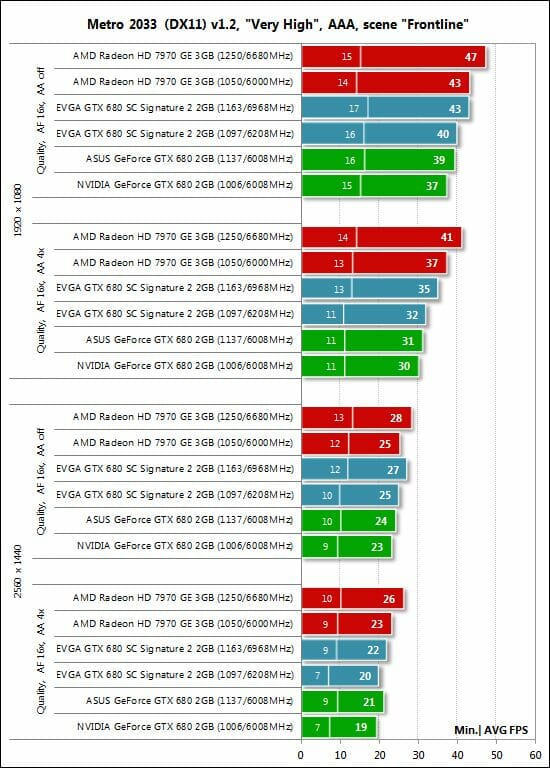
Aliens vs. Predator (2010)
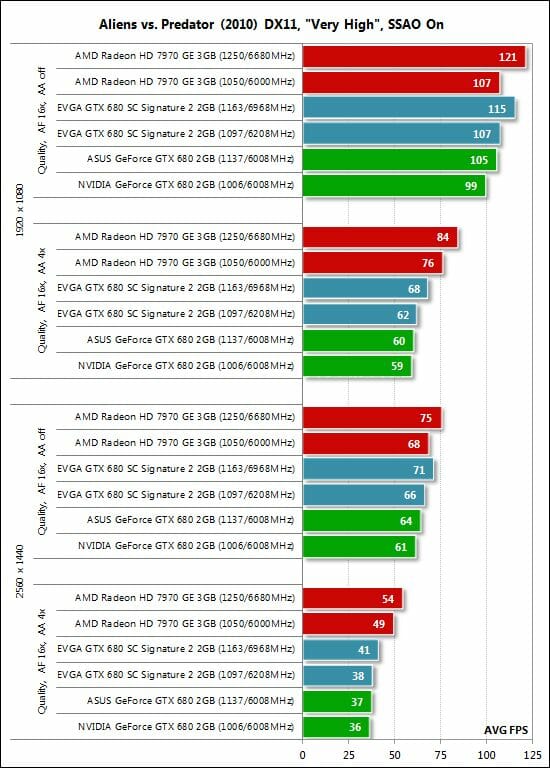
Total War: Shogun 2
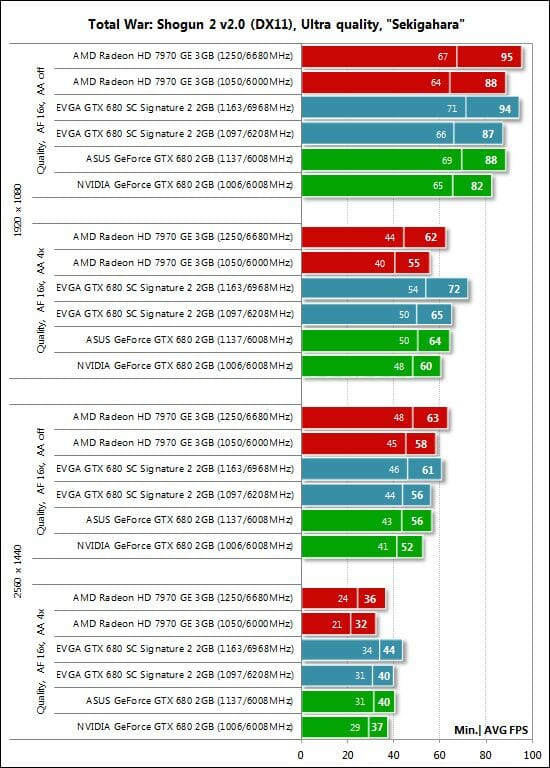
Battlefield 3
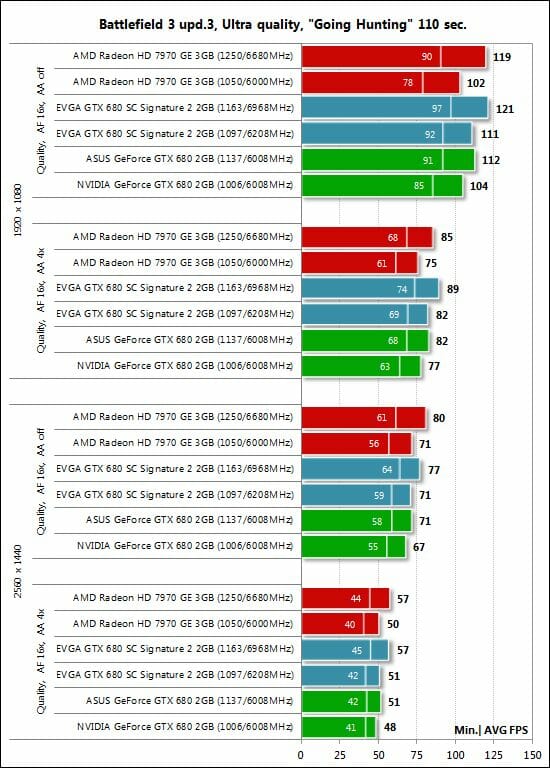
Performance Summary
Our regular readers may not have noticed anything new in these diagrams, especially since we have just reviewed MSI N680GTX Lightning card working at almost the same clock frequencies as the EVGA product. Therefore, we decided to skip the detailed discussion of each separate diagram. However, unlike our previous review, we will offer you a summary performance diagram showing the performance difference between EVGA GeForce GTX SC Signature 2 and the reference GTX 680 graphics card.
Overall, EVGA graphics card is 6-7% faster than the reference Nvidia GeForce GTX 680, which is really good.
Conclusion
What does EVGA offer for the extra $20 added to the recommended price of the GeForce GTX 680? The GeForce GTX 680 SC Signature 2 features an improved power system and comes with increased GPU and memory clock rates which help it be an average 6-7% faster than the reference GTX 680. The high-efficiency and quiet cooler, numerous accessories and 3-year warranty should also be mentioned among its advantages. The overclocking potential wasn’t impressive compared to ASUS and MSI products we had tested earlier but we may have just been unlucky with the particular sample. Summing everything up, we guess that the EVGA GeForce GTX 680 Superclocked Signature 2 fully deserves our Recommended Buy title.